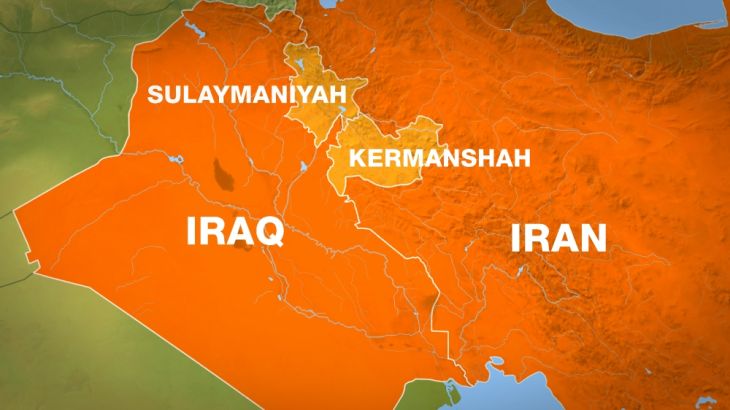Iran-Iraq earthquake: More than 300 die in heavy tremor
Powerful 7.3 magnitude tremor strikes Iran-Iraq border, killing at least 328 people and wounding more than 2,500.

A 7.3 magnitude earthquake struck the border region between Iraq and Iran late on Sunday, killing at least 328 people and injuring an estimated 2,530 more.
As aftershocks continued on Monday and as rescuers sped up their operation, Iran’s state news agency IRNA confirmed the death toll, saying at least 382 of the injured remain in hospital.
Keep reading
list of 4 itemsHow Taiwan learned from the past to reduce the risk from earthquakes
How is Afghanistan coping six months after deadly quakes?
‘Violent rumble’: 4.8 magnitude earthquake rattles New York City, northeast
The US Geological Survey (USGS) said Sunday’s powerful quake hit close to Halabjah, southeast of Sulaymaniyah, a city in the semi-autonomous Kurdish region of northern Iraq.
The tremor, which was felt as far away as Qatar, struck at 9:18pm local time (18:18) GMT. Its epicentre was at a depth of 33.9km.
Most of the victims are believed to be in the Iranian town of Sarpol-e Zahab.
![A man reacts following the earthquake in Sarpol-e Zahab county in Kermanshah, Iran [Tasnim News Agency/Reuters]](/wp-content/uploads/2017/11/48a00dc55cdf444ea9f846dec71a42ae_18.jpeg)
Iranian media said rescue teams deployed in the area amid fears the death toll will rise.
Crossed by several major fault lines, Iran is one of the world’s most seismically active countries.
In 2003, a 6.6 magnitude earthquake flattened the historic city of Bam in southeastern Iran, killing some 26,000 people.
![The quake hit close to Halabjah, southeast of Sulaymaniyah [Al Jazeera]](/wp-content/uploads/2017/11/fede035ea8d14dac8fc2748053f30d59_18.jpeg)
On the other side of the border, Sulaymaniyah officials declared an emergency in the early hours of Monday to assess the aftermath of the quake, according to local Kurdish media.
At least seven people were killed in Iraq, reports said, citing Iraq’s interior ministry.
Turkey was among the first countries to respond.
The Turkish Disaster and Emergency Management Authority (AFAD) said on Twitter that it was sending 20 search and rescue personnel to Iraq, as well as humanitarian relief supplies.
Al Jazeera’s Imran Khan, reporting from the Iraqi capital, Baghdad, said cars came to a standstill in the city as the buildings began to sway.
“Baghdad is not prone to earthquakes so when people began to come outside, the shock was visible on the faces,” he said.
“For the first few seconds, I actually thought an explosion had taken place, but as it carried on – for up to a minute – I realised it was an earthquake,” he added.
Pictures and footage published on social media showed people seeking safety in the streets of Sulaymaniyah while the interiors of buildings shook.
Material damages captured by Rudaw English's managing editor @OsamaGolpy in #Halabja #earthquake pic.twitter.com/6MaFWai7Vb
— Rudaw English (@RudawEnglish) November 12, 2017